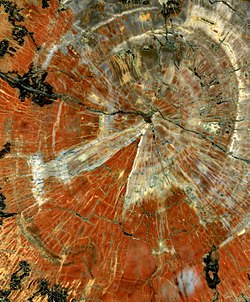User:Abyssal/Prehistory of North America
{ {{Portal maintenance status|date
IntroductionSelected article on prehistoric North America
Megalodon (/ˈmɛɡələdɒn/ MEG-ə-lə-don; meaning "big tooth", from Ancient Greek: μέγας, romanized: (megas), lit. 'big, mighty' and ὀδoύς (odoús), "tooth"—whose stem is odont-, as seen in the genitive case form ὀδόντος, odóntos) is an extinct species of shark that lived approximately 15.9 to 2.6 million years ago, during the Cenozoic Era (middle Miocene to end of Pliocene).
The taxonomic assignment of C. megalodon has been debated for nearly a century, and is still under dispute. The two major interpretations are Carcharodon megalodon (under family Lamnidae) or Carcharocles megalodon (under the family Otodontidae). Consequently, the scientific name of this species is commonly abbreviated C. megalodon in the literature. C. megalodon is regarded as one of the largest and most powerful predators in vertebrate history, and likely had a profound impact on the structure of marine communities. Fossil remains suggest that this giant shark reached a maximum length of 18 metres (59 ft), and also affirm that it had a cosmopolitan distribution. Scientists suggest that C. megalodon looked like a stockier version of the great white shark, Carcharodon carcharias. (see more...) Need help?Do you have a question about Abyssal/Prehistory of North America that you can't find the answer to? Consider asking it at the Wikipedia reference desk. Selected article on the prehistory of North America in science, culture and economicsThe Bone Wars is the name given to a period of intense fossil speculation and discovery during the Gilded Age of American history, marked by a heated rivalry between Edward Drinker Cope and Othniel Charles Marsh. The two paleontologists used underhanded methods to out-compete the other in the field, resorting to bribery, theft, and destruction of bones. The scientists also attacked each other in scientific publications, attempting to ruin the other's credibility and cut off his funding. Originally colleagues who were civil to each other, Cope and Marsh became bitter enemies after several personal slights between them. Their pursuit of bones led them west to rich bone beds in Colorado, Nebraska, and Wyoming. From 1877 to 1892, both paleontologists used their wealth and influence to finance their own expeditions and to procure services and fossils from dinosaur hunters. By the end of the Bone Wars, both men exhausted their funds in fueling their intense rivalry. Cope and Marsh were financially and socially ruined by their efforts to disgrace each other, but their contributions to science and the field of paleontology were massive; the scientists left behind tons of unopened boxes of fossils on their deaths. The feud between the two men led to over 142 new species of dinosaurs being discovered and described. Several historical books and fictional adaptations have also been published about this period of intense paleontological activity. (see more...) Did you know?

Selected image
Quality ContentFeatured prehistory of North America articles - Acrocanthosaurus - Albertosaurus - Allosaurus - Bone Sharps, Cowboys, and Thunder Lizards - Bone Wars -Chicxulub crater - Columbian mammoth - Edward Drinker Cope - Cretaceous–Paleogene extinction event - Daspletosaurus - Deinonychus - Deinosuchus - Dinosaur - Diplodocus - Ediacara biota - Edmontosaurus - Gorgosaurus - Lambeosaurus - Parasaurolophus - Petrified Forest National Park - Stegosaurus - Styracosaurus - Thescelosaurus - Triceratops - Tyrannosaurus - Woolly mammoth Good prehistory of North America articles - ?Oryzomys pliocaenicus - Aetosaur - Archaeomarasmius - Chitinozoan - Cloudinid - Coal ball - Dimetrodon - Stephen Jay Gould - History of paleontology - Kirtlandian - Macabeemyrma - Megalodon - Ornatifilum - Othnielosaurus - Protomycena - Pteranodon - Pterosaur - Saint Croix macaw - Small shelly fauna - Smilodon - Temnospondyli - Tiktaalik - Waptia SubcategoriesThings you can doDesired articles, sorted by how frequently linked to:
Related contentAssociated WikimediaThe following Wikimedia Foundation sister projects provide more on this subject:
|


























